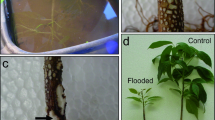Summary
Mesembryanthemum crystallinum plants were grown for 10 weeks in soil culture and, during the final 3 weeks, watered with NaCl solutions varying in concentration between 50 and 500 mM. Plants show an increasingly less negative net CO2 balance and increased malate accumulation in the leaves during the dark with increasing NaCl concentration. There is a positive net CO2 balance above 100 mM with a maximum at 350 mM NaCl. Plants watered with 350 mM NaCl do not display this characteristic feature of crassulacean acid metabolism (CAM) initially, i.e. during the first week after the commencement of NaCl treatment. However, after this adaption period net CO2 balance during the dark begins to approach a positive value. Malate accumulation in the leaves during the dark increases rapidly after the first week of NaCl treatment, reaching a constant level after about 3 weeks. Leaves which develop after commencement of NaCl treatment produce less malate during the dark than leaves which were already present at the onset of NaCl watering. Na+ content in the leaves is higher than Cl- content when plants are watered with NaCl solutions. Four-and-a-half-month-old plants grown under soil culture without addition of NaCl also exhibit CAM, probably because of ion uptake from the soil which causes increase in Na+ and Cl- contents in the leaves. Na2SO4, KCl and K2SO4 have effects similar to those of NaCl on gas exchange reactions of Mesembryanthemum crystallinum.
Similar content being viewed by others
Abbreviations
- CAM:
-
Crassulaceensäurestoffwechsel
Literatur
Greenway, H., Osmond, C. B.: Salt responses of enzymes from species differing in salt tolerance. Plant Physiol. 49, 256–259 (1972).
Hohorst, H. J.: L-(-)-Malat, Bestimmung mit Malatdehydrogenase und NAD. In: H. U. Bergmever, Methoden der enzymatischen Analyse Bd. 2, S. 1544–1548. Weinheim: Verlag Chemie 1970.
Kluge, M., Fischer, K.: Über Zusammenhänge zwischen dem CO2-Austausch und der Abgabe von Wasserdampf durch Bryophyllum daigremontianum Berg. Planta (Berl.) 77, 212–223 (1967).
Nuernbergk, E. L.: Endogener Rhythmus und CO2-Stoffwechsel bei Pflanzen mit diurnalem Säurerhythmus. Planta (Berl.) 56, 28–70 (1961).
Osmond, C. B., Greenway, H.: Saltresponses of carboxylation enzymes from species differing in salt tolerance. Plant Physiol. 49, 260–263 (1972).
Strogonov, P. P.: Physiological basis of salt tolerance of plants. (Translated from Russian.) Israel Program Sci. Transl. (1964).
Sutcliffe, J. F.: Mineral salt absorption in plants. London: Pergamon Press 1962.
von Willert, D. J., Kramer, D.: Feinstruktur und Crassulaceensäurestoffwechsel in Blättern von Mesembryanthemum crystallinum während natürlicher und NaCl-induzierter Alterung. Planta (Berl.), 107, 227–237 (1972).
Winter, K., von Willert, D. J.: NaCl induzierter Crassulaceensäurestoffwechsel bei Mesembryanthemum crystallinum. Z. Pflanzenphys., 67, 166–170 (1972).
Wolf, J.: Beitrag zur Kenntnis des Säurestoffwechsels succulenter Crassulaceen. Planta (Berl.) 15, 572–644 (1931).
Author information
Authors and Affiliations
Rights and permissions
About this article
Cite this article
Winter, K. Zum Problem der Ausbildung des Crassulaceensäurestoffwechsels bei Mesembryanthemum crystallinum unter NaCl-Einfluß. Planta 109, 135–145 (1973). https://doi.org/10.1007/BF00386121
Received:
Issue Date:
DOI: https://doi.org/10.1007/BF00386121



